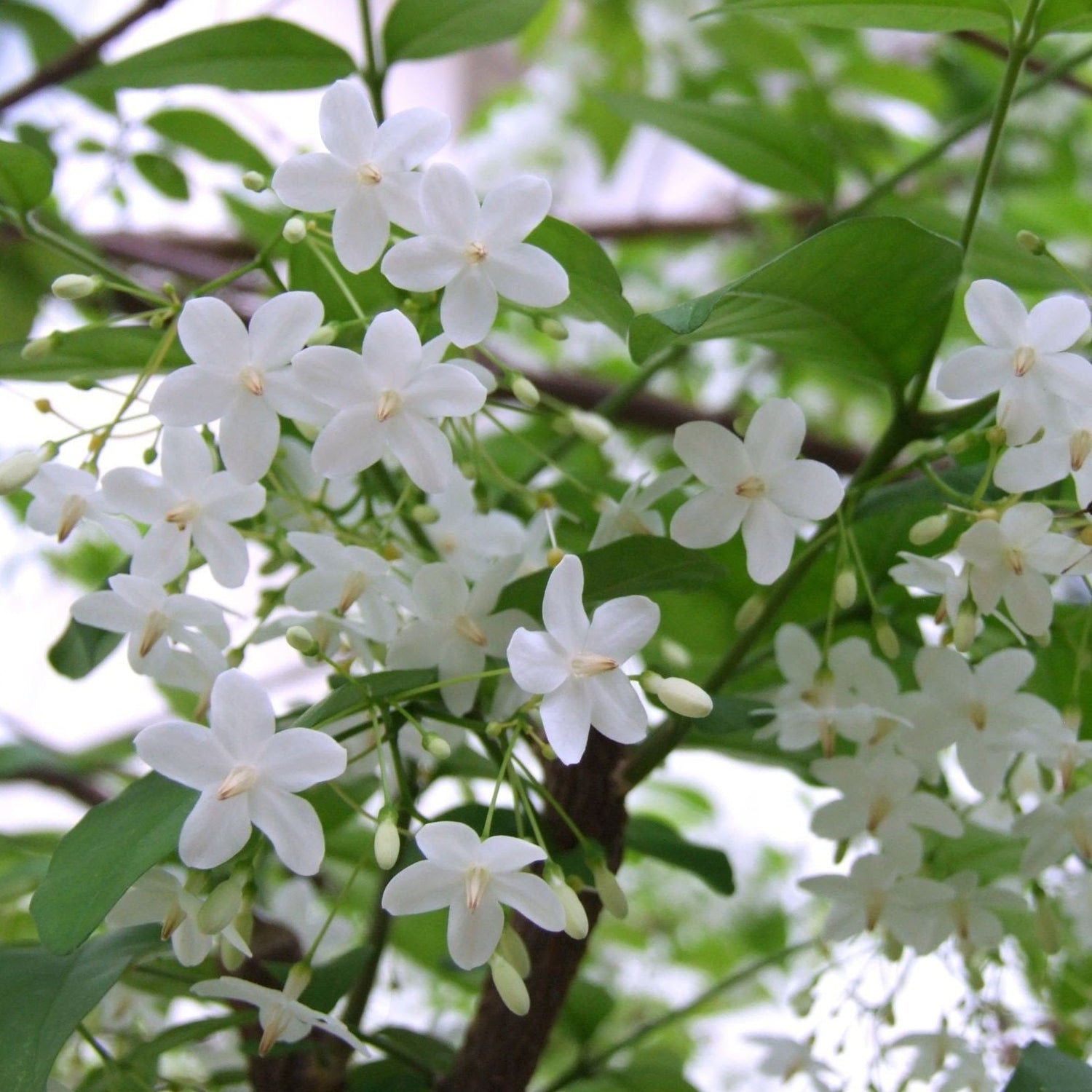Jasmine is more than just a flower—it’s an experience. Its small, delicate blooms exude one of the most recognizable and enchanting fragrances in the botanical world. Whether climbing a trellis or spilling over a pot, jasmine brings romance, nostalgia, and a touch of exotic charm to any garden.
Throughout history, jasmine has symbolized purity, sensuality, and love. When given the right environment, it offers both visual delight and olfactory magic, making it a treasured addition to gardens and courtyards around the globe.

Portrait of the Jasmine
Jasmine belongs to the Oleaceae family and includes many species, such as Jasminum officinale (common jasmine), Jasminum sambac (Arabian jasmine), and Jasminum polyanthum (pink jasmine), each known for their star-shaped blooms and intoxicating scent.
- Type: Evergreen or deciduous shrub or vine
- Family: Oleaceae
- Common Names: Jasmine, Common Jasmine, Arabian Jasmine, Star Jasmine (though technically Trachelospermum)
Foliage and Form
Jasmine features opposite, pinnate leaves that may be glossy or soft, depending on the species. Vining types require support, while shrub forms can be neatly pruned into shape.
- Height: 1.5–6 m (5–20 ft), depending on type
- Spread: 1–3 m (3–10 ft)
- Growth Habit: Climbing, vining, or mounding depending on species
Blooms and Fragrance
Jasmine’s true signature is its heavenly fragrance, released from tiny, five-petaled white or pale pink blossoms. Flowers typically appear in clusters and open more prolifically during warm evenings.
- Bloom Time: Spring to late summer (some bloom into fall)
- Color: White, pale yellow, or pink
- Fragrance: Intensely sweet and floral—best in the evening
The Right Time to Plant, Prune, and Enjoy Jasmine
| Month | Planting | Flowering | Pruning |
|---|---|---|---|
| January | ❌ | ❌ | ✅ Light shaping in warm zones |
| February | ✅ Dormant planting | ❌ | ✅ Remove dead wood |
| March | ✅ Ideal time | ❌ | ✅ Formative pruning before buds |
| April | ✅ | ✅ Begins in warm climates | ❌ |
| May | ✅ | ✅ Peak blooming | ❌ |
| June | ❌ | ✅ Continues blooming | ❌ |
| July | ❌ | ✅ | ✅ Deadhead faded blooms |
| August | ❌ | ✅ Late bloomers | ✅ Light pruning for shape |
| September | ✅ Container-grown | ✅ (varies by species) | ✅ Clean-up cuts |
| October | ✅ Cooler climate planting | ❌ | ✅ Prepare for winter pruning |
| November | ✅ (mild zones only) | ❌ | ✅ Remove excess growth |
| December | ❌ | ❌ | ✅ Light pruning indoors or in zones 9+ |
✅ = Recommended ❌ = Not advised
Watering, Sunlight, and Environment for Jasmine
Watering
Jasmine prefers consistent moisture, especially during the growing season. However, it doesn’t like soggy feet.
- When to Water: 1–2 times per week, more in hot weather
- How Much: Deep, even watering
- Watch out for: Root rot in poorly drained soil
Sunlight
For maximum bloom and fragrance, jasmine needs plenty of sunlight. Some species tolerate light shade but flower less vigorously.
- Ideal Exposure: Full sun to partial shade
- Shady Sites: Less fragrance, reduced blooming
Indoor vs Outdoor
Jasmine can be grown indoors near a sunny window but thrives best outdoors where it can sprawl or climb freely.
- Best Location: Trellises, fences, large containers, or sunny patios
- Avoid: Deep shade or enclosed, dry indoor air
Temperature
Most jasmines enjoy mild to warm climates, though some are frost-tender and need protection.
- Optimal Range: 15–30°C (59–86°F)
- Hardiness Zones: USDA zones 6–11 (varies by species)
- Protection Tip: Mulch roots and shelter from harsh winds
Ideal Soil Conditions for Growing Jasmine
| Soil Feature | Optimal Condition | Why It Matters |
|---|---|---|
| Soil Type | Loamy or sandy | Encourages proper drainage and root spread |
| Texture | Loose and well-aerated | Prevents waterlogging and allows oxygen flow |
| Drainage | Excellent | Avoids root rot and fungal diseases |
| Moisture | Moist but never soggy | Promotes steady growth and flowering |
| Soil pH | Slightly acidic to neutral (6.0–7.0) | Ensures nutrient uptake and scent quality |
| Fertility | Moderate | Too much nitrogen = fewer flowers |
Common Problems & Solutions
| Issue 🐾 | Symptoms 🔍 | Solutions 🛠️ |
|---|---|---|
| No Blooms 🌿 | Healthy plant, no flowers | More sun, avoid excess nitrogen, prune wisely |
| Yellow Leaves 🍂 | Overwatering or poor drainage | Improve drainage, water less frequently |
| Aphids 🐜 | Sticky residue, curled new growth | Use insecticidal soap or neem oil |
| Powdery Mildew 🍃 | White coating on leaves | Improve airflow, prune overcrowded branches |
| Leggy Growth 🌱 | Sparse foliage, long bare stems | Prune back to encourage bushier form |
With its irresistible scent and graceful blooms, jasmine adds both romance and sensory delight to any setting. Whether draped over an arbor or climbing a sunlit fence, it rewards the attentive gardener with seasons of bloom and elegance. A plant that appeals to sight, scent, and sentiment—jasmine is a living poem in your garden.